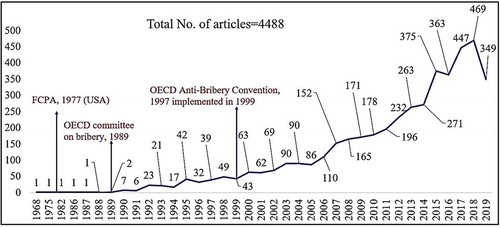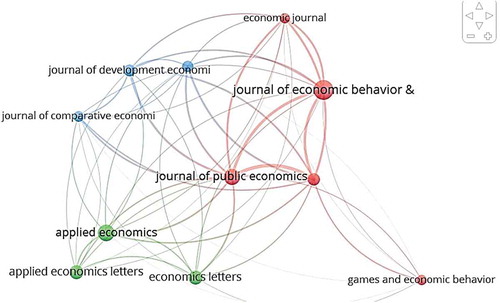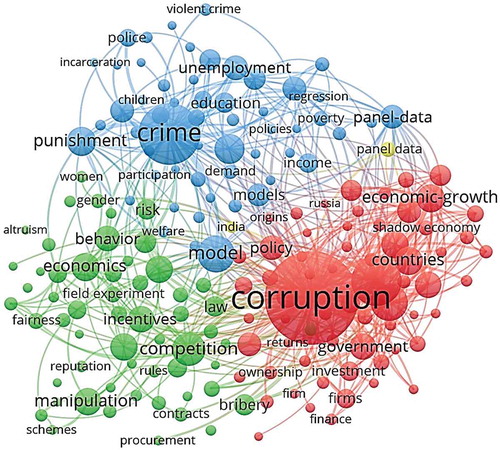ABSTRACT
We conducted a bibliometric analysis of the literature on corruption in the discipline of economics (4,488 articles) over the past 51 years between 1968–2019. Through this methodology, we identified seven research streams: (1) the economic framework of crime and corruption, (2) the legal institutions and corruption, (3) the effect of corruption on aspects of national economics, (4) the combating and monitoring of corruption, (5) the determinants of corruption, (6) political institutions and corruption, and (7) the effect of corruption on firms. In addition to these research clusters, we also identified the key journals, articles, countries, institutions, authors, data sources, measurements, theoretical frameworks, and networks dealing with this issue. Finally, we suggested 20 future research questions.
I. Introduction
Economists traditionally view corruption as a misuse of power for private gain (Shleifer and Vishny Citation1993; Treisman Citation2000). Corruption has been blamed for the failure of policy in some developing countries (Treisman Citation2000) and found to reduce investment, economic growth, and development (Mauro Citation1995; Bardhan Citation2017). As a result, academic researchers, controlling bodies (e.g., the IMF,Footnote 1 OECD,Footnote 2 and World Bank) and nations (e.g., America’s FCPA of 1977Footnote 3 and the OECD committee on bribery 1989Footnote 4 ) started reviewing and analysing the pathology of corruption and crime in the economy and society. Consequently, a substantial but scattered body of literature on corruption in economics has developed. We synthesized 51 years of research (between 1968 and 2019) (see ) to provide more clarity on the research clusters and research directions in the field.
To explore the literature, we conducted a bibliometric citation analysis of 4,488 articles on corruption in economics (Yuret Citation2014, Citation2018; Rath and Wohlrabe Citation2015a; Zupic and Čater Citation2015; Sommer and Wohlrabe Citation2016; Meyer and Wohlrabe Citation2017; Bahoo, Alon, and Paltrinieri Citation2019; Bahoo Citation2020). Our analysis contributes to the literature by answering the following questions: (1) What are the leading research streams in the literature on corruption in economics? (2) What are the key journals, articles, countries, institutions, authors, data sources, measurements, theoretical frameworks, and networks in this field? (3) What are the future research directions?
II. Method
Our method consists of two techniques. The first is bibliometric analysis (Broadus Citation1987; Mingers and Leydesdorff Citation2015; Zupic and Čater Citation2015; Bahoo, Alon, and Paltrinieri Citation2020). The second is content analysis (Gaur and Kumar Citation2018; Ahmed, Bahoo, and Ayub Citation2019; Ahmed, Bahoo, Aslam, and QureshiCitation2020). We utilized these techniques to conduct five analyses: (1) citation analysis, (2) co-citation analysis, (3) cartography analysis, (4) citation network analysis, and (5) content analysis. Our software tools consisted of the HistCite and VOSviewer software programmes.
Using 18 keywords for corruption that included combinations of the words ‘economics,’ ‘economy,’ and ‘economic,’ we searched the ISI Web of Knowledge (WOK) database for articles on the topic. We selected these words using a systematic, three-step process outlined in . Our first search resulted in 5,671 articles. In the next step, we excluded irrelevant articles by reviewing titles and abstracts. Our final set included 4,488 articles published between 1968 and 2019 dealing with corruption in economics. , which illustrates the growth in articles per year on the topic, shows a sharp growth trend beginning in the 1990 s after the Western world passed anti-corruption laws and formed an OECD committee on bribery.
III. Results
Influential aspects of the literature
Key journals and networks
Three hundred seventy-two journals published the 4,488 articles in our sample. Using HistCite, we ranked the top 11 journals that had the largest number of citation references and articles published on the topic (see ). In both rankings, the journals Applied Economics and Applied Economics Letters emerged as the most influential and provided quality research on corruption in economics. Furthermore, using VOSviwer we determined that Applied Economics Letters was also among the top-cited journal networks (see ).
Influential countries, institutions, authors, articles, and networks
Using these two software programs, we ranked the most influential countries, institutions, authors, and networks in the field (see ). With regard to authors, 6,828 authors wrote the 4,488 articles in our sample. illustrates the top 11 authors and networks among them, which is useful for policymakers and prospective researchers for future projects. With regard to countries and institutions, most studies came from Western countries such as the US and Europe, reflecting the serious desire to overcome the problem of corruption and crime. China is also emerging as a major contributor.
Our sample of 4,488 articles had 10,629 total local citations (TLC) and 97319 total global citations (TGC). We also divided the top 11 trending articles from 1968 to 2019 into two categories based on TLC/t (total local citations per year) and TGC/t (total global citations per year) (see ).
Keyword networks to identify research areas
The keywords assigned by authors or the ISI WOK database to a research article represent the field of study and directions of the literature. Therefore, using VOSviwer we created keyword networks based on the repetition of words, which is called cartography analysis. depicts the resulting networks and identifies the associated research areas. As the figure indicates, the most repeated keywords in the literature are corruption, crime, economy, economic growth, deterrence, punishment, law, institutions, models, determinants, causes, and consequences. On the other hand, the keywords that appeared least frequently are firm performance, firm, earning management, political institutions, politics. The findings from confirm that two critical areas of research–political institutions and corruption, and the effect of corruption on firms–are underdeveloped and neglected. These two areas of research contain knowledge gaps that suggest the need for further investigation.
Citation mapping: identification of research streams, trends, and synthesis
We used bibliometric co-citation analysis (Cainelli et al. Citation2012; Rath and Wohlrabe Citation2015b; Aria and Cuccurullo Citation2017; Paltrinieri et al. Citation2019) and content analysis (Bahoo et al. Citation2018; Gaur and Kumar Citation2018) to identify the research streams in the literature on corruption in economics. In the first step, bibliometrics co-citation analysis identified the 70 top-cited papers, resulting in the citation map depicted in . Second, we applied traditional content analysis to these 70 articles to understand the content (Bahoo, Hassan, Paltrinieri, and Khan Citation2019). This quantitative and qualitative process resulted in the following seven research streams in the literature: (1) the economic framework of crime and corruption, (2) the legal institutions and corruption, (3) the effect of corruption on aspects of national economics, (4) the combating and monitoring of corruption, (5) the determinants of corruption, (6) political institutions and corruption, and (7) the effect of corruption on firms. The 70 key papers are listed under each stream in .
Figure 5. Research streams in the literature created by HistCite. *Top 70 influential articles with a minimum of 20 TLCs, resulting in the seven research streams listed in Table A3
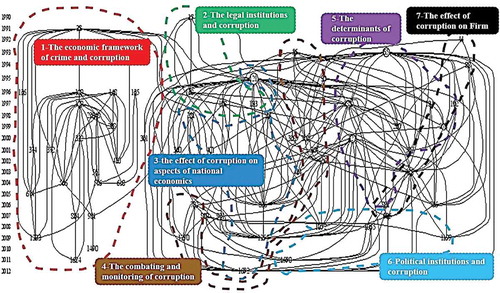
These seven research streams are interconnected. The key frameworks of corruption and crime (Becker Citation1968; Rose-Ackerman Citation1975; Olken Citation2009) are helpful in explaining the effect of corruption on the economy (Macrae Citation1982; Mauro Citation1995; Fisman and Svensson Citation2007), businesses and firms (Shleifer and Vishny Citation1994; Dove Citation2017). Nations and controlling bodies have established laws and legal institutions (Tirole Citation1996; Devaraj and Patel Citation2017) to combat financial and political corruption (Alam Citation1989; Goel and Saunoris Citation2017) by identifying the key determinants of corruption (Dey Citation1989; Shleifer and Vishny Citation1993; Lee and Holoviak Citation2006).
We also reviewed the titles and abstracts of our sample to create a publication trend in each research stream during the last 51 years. shows that the first (the economic framework of crime and corruption) and third (the effect of corruption on aspects of national economics) research streams, which economists have been exploring extensively since 1990, peaked in 2015. The research on the second stream (legal institutions and corruption) has remained constant because researchers are concerned about the implementation of laws and regulations. The fourth (the combating and monitoring of corruption) and fifth (the determinants of corruption) streams are at the regeneration stage, as researchers are revisiting and exploring the measures and determinants of corruption and crime in this era of globalization and internationalization. However, the research on the sixth (political institutions and corruption) and seventh (the effect of corruption on firms) streams is underdeveloped and comparatively negelected. The keyword analysis in also confirmed the underdevelopment of the sixth and seventh research streams. Therefore, in Section 4, we recommend future research directions in these two areas.
Figure 6. Publication trends in the seven research streams between 1968 and 2019. *However, more extensive research started on the topic in the 1990 s
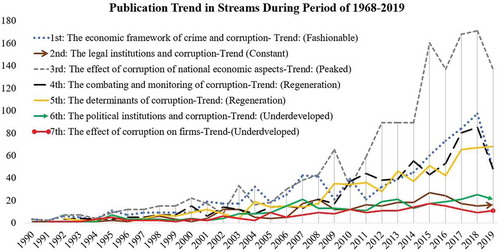
Finally, we also summarized the data sources, measurements, and theoretical frameworks used in the 70 most influential papers in . This listing and summary of the critical aspects of these 70 papers should be helpful to researchers in producing additional quality research on the topic.
IV. Future research agenda
We used bibliometric citation and content analyses to identify future agendas (Bahoo Citation2020). First, we created a citation map () using the top 70 papers. Second, through HistCite we determined the trending (between 2009–2019) and most influential articles and reviewed them. Third, we analysed recent articles published in 2017, 2018, and 2019 to avoid citation bias. Fourth, we used the idea of putting ‘old wine in new bottles’ (Dunning, Kim, and Park Citation2008, 158) to re-explore past frameworks, theories, models, and inferences concerning corruption and crime in developing, emerging, and developed countries. Finally, we converted these research gaps into future research questions under each research stream. The results appear in .
V. Conclusion
Corruption is a significant challenge for all societies and has a negative effect on their economic growth and development. It is one of the main reasons for the slow growth of developing countries. It exists in several forms: financial, non-financial, public, private, petty, and grand. It also occurs at the upper, middle, and lower levels of society in developed as well as underdeveloped countries. Due to globalization and the digitalization of the world economy, it has become an even more complex phenomenon. Thus, we must establish anti-corruption systems and revisit economic frameworks and models of corruption and crime. In addition, political corruption is a critical challenge for countries at all levels of development. Hence, it is essential to understand and explore the economic model of crime and corruption and its relationship to legal institutions, political institutions, and firms. These goals motivated our desire to summarize the literature on corruption in economics. While we used the full ISI WOK database, we recommend that future bibliometric studies on the topic use Scopus and Google Scholar database to validate our findings.
Disclosure statement
No potential conflict of interest was reported by the authors.
Notes
1 IMF: International Monetary Fund.
2 OECD: Organization of Economic Co-operation and Development.
3 America’s FCPA of 1977: The Foreign Corrupt Practice Act of 1977. Retrieved from https://www.justice.gov/criminal-fraud/foreign-corrupt-practices-act.
4 OECD Committee on Bribery 1989: Retrieved from https://www.oecd.org/daf/anti-bribery/38865251.pdf.
References
- Acemoglu, D. , S. Johnson , and J. A. Robinson . 2012. “The Colonial Origins of Comparative Development: An Empirical Investigation: Reply.” American Economic Review 102 (6): 3077–3110.
- Acemoglu, D. , and T. Verdier . 1998. “Property Rights, Corruption, and the Allocation of Talent: A General Equilibrium Approach.” The Economic Journal 108 (450): 1381–1403.
- Acemoglu, D. , and T. Verdier . 2000. “The Choice between Market Failures and Corruption.” American Economic Review 90 (1): 194–211.
- Ades, A. , and R. Di Tella . 1999. “Rents, Competition, and Corruption.” The American Economic Review 89 (4): 982–993.
- Ahmed, F. , S. Bahoo , and A. Ayub . 2019. “Accountability, Governance, and Structure of Non-Profit Organizations: Evidence from Ghana, South Africa, and Zimbabwe.” New Horizons 13 (2): 19–36.
- Ahmed, F. , S. Bahoo , S. Aslam , and M. A. Qureshi . 2020. “Meta-Analysis on American Presidential Election-2016 and American Stock Market.” Estudios de Economia Aplicada 38(1): 1 –10.
- Aidt, T. , J. Dutta , and V. Sena . 2008. “Governance Regimes, Corruption, and Growth: Theory and Evidence.” Journal of Comparative Economics 36 (2): 195–220.
- Alam, M. S. 1989. “Anatomy of Corruption: An Approach to the Political Economy of Underdevelopment.” American Journal of Economics and Sociology 48 (4): 441–456.
- Alon, I. , S. Li , and J. Wu . 2016. “Corruption, Regime Type, And Economic Growth.” Public Finance and Management 16 (4): 332–361.
- Alon, I. , and T. T. Herbert . 2009. “A Stranger in A Strange Land: Micro Political Risk and the Multinational Firm.” Business Horizons 52 (2): 127–137. doi:10.1016/j.bushor.2008.09.004.
- Andvig, J. C. , and K. O. Moene . 1990. “How Corruption May Corrupt.” Journal of Economic Behavior & Organization 13 (1): 63–76.
- Aria, M. , and C. Cuccurullo . 2017. “Bibliometrix: An R-tool for Comprehensive Science Mapping Analysis.” Journal of Informetrics 11 (4): 959–975.
- Bahoo, S. 2020. “Corruption in Banks: A Bibliometric Review and Agenda.” Finance Research Letters . (In Press). doi:10.1016/j.frl.2020.101499.
- Bahoo, S. , I. Alon , and A. Paltrinieri . 2019. “Corruption in International Business: A Review and Research Agenda.” International Business Review . (in Press). doi:10.1016/j.ibusrev.2019.101660.
- Bahoo, S. , I. Alon , and A. Paltrinieri . 2020. “Sovereign Wealth Funds: Past, Present, Future.” International Review of Financial Analysis . (in Press). doi:10.1016/j.irfa.2019.101418.
- Bahoo, S. , M. K. Hassan , A. Paltrinieri , and A. Khan . 2019. “A Model of the Islamic Sovereign Wealth Fund.” Islamic Economic Studies 27 (1): 2–22.
- Bahoo, S. , S. Saeed , M. J. Iqbal , and S. Nawaz . 2018. “Role of China-Pakistan Economic Corridor in Pakistan’ S Trade, Investment, Energy, Infrastructure, and Stock Market.” Journal of Independent Studies and Research-Management, Social Sciences and Economics 16 (1): 63–84.
- Bai, J. , S. Jayachandran , E. J. Malesky , and B. A. Olken . 2017. “Firm Growth and Corruption: Empirical Evidence from Vietnam.” The Economic Journal 129 (618): 651–677.
- Baltagi, B. H. 2006. “Estimating an Economic Model of Crime Using Panel Data from North Carolina.” Journal of Applied Econometrics 21 (4): 543–547.
- Banerjee, A. V. 1997. “A Theory of Misgovernance.” The Quarterly Journal of Economics 112 (4): 1289–1332.
- Bardhan, P. 1997. “Corruption and Development: A Review of Issues.” Journal of Economic Literature 35 (3): 1320-346.
- Bardhan, P. 2017. “Corruption and Development: A Review of Issues.” In Political Corruption (3rd), 1–850. New York: Routledge.
- Barr, A. , and D. Serra . 2010. “Corruption and Culture: An Experimental Analysis.” Journal of Public Economics 94 (11–12): 862–869.
- Basu, K. , S. Bhattacharya , and A. Mishra . 1992. “Notes on Bribery and the Control of Corruption.” Journal of Public Economics 48 (3): 349–359.
- Becker, G. S. 1968. “Crime and Punishment: An Economic Approach.” The Economic Dimensions of Crime 76 (2) : 169–217.
- Beltrán, A. 2015. “Does Corruption Increase or Decrease Employment in Firms?” Applied Economics Letters 23 (5): 361–364.
- Berdiev, A. N. , Y. Kim , and C.-P. Chang . 2013. “Remittances and Corruption.” Economics Letters 118 (1): 182–185.
- Bertrand, M. , and S. Mullainathan . 2004. “Are Emily and Greg More Employable than Lakisha and Jamal? A Field Experiment on Labor Market Discrimination.” American Economic Review 94 (4): 991–1013.
- Besley, T. , and J. Mclaren . 1993. “Taxes and Bribery: The Role of Wage Incentives.” The Economic Journal 103 (416): 119.
- Bliss, C. , and R. D. Tella . 1997. “Does Competition Kill Corruption?” Journal of Political Economy 105 (5): 1001–1023. doi:10.1086/262102.
- Broadus, R. 1987. “Toward a Definition of “Bibliometrics”.” Scientometrics 12 (5–6): 373–379.
- Cadot, O. 1987. “Corruption as A Gamble.” Journal of Public Economics 33 (2): 223–244.
- Cainelli, G. , M. A. Maggioni , T. E. Uberti , and A. D. Felice . 2012. “Co-Authorship and Productivity among Italian Economists.” Applied Economics Letters 19 (16): 1609–1613.
- Des, A. , and R. D. Tella . 1997. “National Champions and Corruption: Some Unpleasant Interventionist Arithmetic.” The Economic Journal 107 (443): 1023–1042.
- Devaraj, S. , and P. C. Patel . 2017. “An Examination of the Effects of 2014 Concealed Weapons Law in Illinois on Property Crimes in Chicago.” Applied Economics Letters 25 (16): 1125–1129.
- Dey, H. K. 1989. “The Genesis and Spread of Economic Corruption: A Microtheoretic Interpretation.” World Development 17 (4): 503–511.
- Donohue, J. , and S. Levitt . 2001. “The Impact of Legalized Abortion on Crime.” The Quarterly Journal of Economics 116 (2): 379–420. doi:10.3386/w8004.
- Dove, J. A. 2017. “Some Additional Evidence on the Interplay between Corruption, Tax Policy and Firm Entry Using US States.” Applied Economics Letters 24 (18): 1307–1310.
- Duggan, M. 2001. “More Guns, More Crime.” Journal of Political Economy 109 (5): 1086–1114. doi:10.3386/w7967.
- Dunning, J. , C. Kim , and D. Park . 2008. “Old Wine in New Bottles: A Comparison of Emerging-market TNCs Today and Deveoped-country TNCs Thirty Years Ago.” In The Rise of Transnational Corporations from Emerging Markets: Threat or Opportunity? , edited by K. P. Sauvant , 158–182. New York: Edward Elgar.
- Ehrlich, I. 1996. “Crime, Punishment, and the Market for Offenses.” Journal of Economic Perspectives 10 (1): 43–67.
- Engel, C. 2011. “Dictator Games: A Meta Study.” Experimental Economics 14 (4): 583–610.
- Faccio, M. 2006. “Politically Connected Firms.” American Economic Review 96 (1): 369–386.
- Fan, C. S. , C. Lin , and D. Treisman . 2009. “Political Decentralization and Corruption: Evidence from around the World.” Journal of Public Economics 93 (1–2): 14–34.
- Ferraz, C. , and F. Finan . 2008. “Exposing Corrupt Politicians: The Effects of Brazils Publicly Released Audits on Electoral Outcomes*.” Quarterly Journal of Economics 123 (2): 703–745. doi:10.1162/qjec.2008.123.2.703.
- Ferraz, C. , and F. Finan . 2011. “Electoral Accountability and Corruption: Evidence from the Audits of Local Governments.” American Economic Review 101 (4): 1274–1311.
- Fisman, R. , and E. Miguel . 2007. “Corruption, Norms, and Legal Enforcement: Evidence from Diplomatic Parking Tickets.” Journal of Political Economy 115 (6): 1020–1048.
- Fisman, R. , and J. Svensson . 2007. “Are Corruption and Taxation Really Harmful to Growth? Firm-Level Evidence.” Journal of Development Economics 83 (1): 63–75.
- Franses, P. H. , and B. D. Groot . 2015. “Corruption and Inequality of Wealth Amongst the Very Rich.” Quality & Quantity 50 (3): 1245–1252.
- Friedman, E. , S. H. Johnson , D. Kaufmann , and P. Zoido . 1999. “Dodging the Grabbing Hand: The Determinants of Unofficial Activity in 69 Countries.” Journal of Public Economics 76 (3): 459–493.
- Gaur, A. , and M. Kumar . 2018. “A Systematic Approach to Conducting Review Studies: An Assessment of Content Analysis in 25 Years in IB Research.” Journal of World Business 53 (2): 280–289.
- Glaeser, E. , and R. Saks . 2006. “Corruption in America.” Journal of Public Economics 90 (6): 1053–1072.
- Goel, R. K. , J. Budak , and E. Rajh . 2014. “Private Sector Bribery and Effectiveness of Anti-Corruption Policies.” Applied Economics Letters 22 (10): 759–766.
- Goel, R. K. , and J. W. Saunoris . 2017. “Political Uncertainty and International Corruption.” Applied Economics Letters 24 (18): 1298–1306.
- Grogger, J. 1995. “The Effect of Arrests on the Employment and Earnings of Young Men.” The Quarterly Journal of Economics 110 (1): 51–71. doi:10.2307/2118510.
- Harel, A. , and U. Segal . 1999. “Criminal Law and Behavioral Law and Economics: Observations on the Neglected Role of Uncertainty in Deterring Crime.” American Law and Economics Review 1 (1): 276–312.
- Hindriks, J. , M. Keen , and A. Muthoo . 1999. “Corruption, Extortion, and Evasion.” Journal of Public Economics 74 (3): 395–430.
- HistCite Glossary . (2018). “HistCite Glossary.” http://www.public.asu.edu/~majansse/ihdp/glossary.html
- Horovitz, A. , and U. Segal . 2007. The Ambiguous Nature of Ambiguity and Crime Control . N.Y.U. J.L. LIBERTY 541.
- Imai, S. , H. Katayama , and K. Krishna . 2006. Crime and Young Men: The Role of Arrest, Criminal Experience, and Heterogeneity . Cambridge, MA: NBER.
- Jiménez, A. , and I. Alon . 2018. “Corruption, Political Discretion and Entrepreneurship.” Multinational Business Review 26 (2): 111–125. doi:10.1108/mbr-01-2018-0009.
- Jimenez, A. , J. C. P. Regaliza , J. A. J. Eguizábal , and I. Alon . 2017. “Political Discretion and Corruption: The Impact of Institutional Quality on Formal and Informal Entrepreneurship.” European Journal of International Management 11 (3): 280. doi:10.1504/ejim.2017.10004232.
- Keefer, P. , and S. Knack . 1997. “Why Don’t Poor Countries Catch Up? A Cross-National Test of an Institutional Explanation.” Economic Inquiry 35 (3): 590–602.
- Kim, J. , and S. J. McMillan . 2008. “Evaluation of Internet Advertising Research: A Bibliometric Analysis of Citations from Key Sources.” Journal Of Advertising 37 (1): 99–112.
- Knack, S. 2001. “Aid Dependence and the Quality of Governance: Cross-Country Empirical Tests.” Southern Economic Journal 68 (2): 310. doi:10.2307/1061596.
- Lambsdorff, J. G. 2003. “How Corruption Affects Productivity.” Kyklos 56 (4): 457–474.
- Lee, D. Y. , and S. J. Holoviak . 2006. “Unemployment and Crime: An Empirical Investigation.” Applied Economics Letters 13 (12): 805–810.
- Levitt, S. 1995a. “Using Electoral Cycles in Police Hiring to Estimate the Effect of Police on Crime.” American Economic Review 92: 1236–1243. doi:10.3386/w4991.
- Levitt, S. 1995b. “Why Do Increased Arrest Rates Appear to Reduce Crime: Deterrence, Incapacitation, or Measurement Error?” Economic Inquiry 36: 353–372. doi:10.3386/w5268.
- Levitt, S. D. 2004. “Understanding Why Crime Fell in the 1990s: Four Factors that Explain the Decline and Six that Do Not.” Journal of Economic Perspectives 18 (1): 163–190.
- Li, Q. , and W. Long . 2017. “Do Parole Abolition and Truth-In-Sentencing Deter Violent Crimes in Virginia?” Empirical Economics 55 (4): 2027–2045.
- Li, S. , I. Alon , and J. Wu . 2017. “Corruption May Worsen in Democratizing Economies: But Don’t Let It Erode Our Faith in Democracy.” Modern China Studies 24 (2): 184–188.
- Lui, F. T. 1986. “A Dynamic Model of Corruption Deterrence.” Journal of Public Economics 31 (2): 215–236.
- Machin, S. , and C. Meghir . 2004. “Crime and Economic Incentives.” The Journal of Human Resources 39 (4): 958.
- Macrae, J. 1982. “Underdevelopment and the Economics of Corruption: A Game Theory Approach.” World Development 10 (8): 677–687.
- Mauro, P. 1995. “Corruption and Growth.” Quarterly Journal of Economics , 110 (3): 681–712.
- Mauro, P. 1998. “Corruption and the Composition of Government Expenditure.” Journal of Public Economics 69 (2): 263–279.
- May, J. W. , W. Pyle , and P. M. Sommers . 2002. “Does Governance Explain Unofficial Activity?” Applied Economics Letters 9 (8): 537–539.
- Meghir, C. , M. Palme , and M. Schnabel (2012). “The Effect of Education Policy on Crime: An Intergenerational Perspective.” Working Paper No. 18145 , NBER.
- Meyer, J. , and K. Wohlrabe . 2017. “Standing on the Shoulder of Giants: The Aspect of Free-Riding in RePEc Rankings.” Applied Economics Letters 25 (4): 223–228.
- Mian, A. R. , and A. I. Khwaja . 2004. “Do Lenders Favor Politically Connected Firms? Rent Provision in an Emerging Financial Market.” SSRN Electronic Journal . doi:10.2139/ssrn.631703.
- Mingers, J. , and L. Leydesdorff . 2015. “A Review of Theory and Practice in Scientometrics.” European Journal of Operational Research 246 (1): 1–19.
- Mo, P. H. 2001. “Corruption and Economic Growth.” Journal of Comparative Economics 29: 66–79.
- Mookherjee, D. , and I. P. L. Png . 1995. “Corruptible Law Enforcers: How Should They Be Compensated?” The Economic Journal 105 (428): 145.
- Okunlola, O. C. 2018. “Political Regime Types and Economic Development in Nigeria: Significance of Conflict and Corruption.” Journal of Interdisciplinary Economics 31 (2): 183–216.
- Olken, B. , and R. Pande . 2012. “Corruption in Developing Countries.” Annual Review of Economics 4 (1): 479–509.
- Olken, B. A. 2006. “Corruption and the Costs of Redistribution: Micro Evidence from Indonesia.” Journal of Public Economics 90 (4–5): 853–870.
- Olken, B. A. 2007. “Monitoring Corruption: Evidence from a Field Experiment in Indonesia.” Journal of Political Economy 115 (2): 200–249.
- Olken, B. A. 2009. “Corruption Perceptions Vs. Corruption Reality.” Journal of Public Economics 93 (7–8): 950–964.
- Paltrinieri, A. , M. K. Hassan , S. Bahoo , and A. Khan . 2019. “A Bibliometric Review of Sukuk Literature.” International Review of Economics & Finance . (In Press). https://www.sciencedirect.com/science/article/pii/S1059056018308165
- Pellegrini, L. , and R. Gerlagh . 2004. “Corruptions Effect on Growth and Its Transmission Channels.” Kyklos 57 (3): 429–456.
- Polinsky, A. , and S. Shavell . 2001. “Corruption and Optimal Law Enforcement.” Journal of Public Economics 81 (1): 1–24. doi:10.1016/s0047-2727(00)00127-4.
- Rath, K. , and K. Wohlrabe . 2015a. “Recent Trends in Co-Authorship in Economics: Evidence from RePEc.” Applied Economics Letters 23 (12): 897–902.
- Rath, K. , and K. Wohlrabe . 2015b. “Trends in Economics Publications Represented by JEL Categories between 2007 and 2013.” Applied Economics Letters 23 (9): 660–663.
- Rauch, J. E. , and P. B. Evans . 2000. “Bureaucratic Structure and Bureaucratic Performance in Less Developed Countries.” Journal of Public Economics 75 (1): 49–71.
- Rose-Ackerman, S. 1975. “The Economics of Corruption.” Journal of Public Economics 4 (2): 187–203.
- Sah, R. K. 1991. “Social Osmosis and Patterns of Crime.” Journal of Political Economy 99 (6): 1272–1295.
- Saha, A. , and G. Poole . 2000. “The Economics of Crime and Punishment: An Analysis of Optimal Penalty.” Economics Letters 68 (2): 191–196.
- Shleifer, A. , and R. W. Vishny . 1993. “Corruption.” The Quarterly Journal of Economics 108 (3): 599–617.
- Shleifer, A. , and R. W. Vishny . 1994. “Politicians and Firms.” The Quarterly Journal of Economics 109 (4): 995–1025.
- Simeon Djankov, S. , L. La Porta , F. Lopez-de-Silanes , and A. Shleifer . 2003. “Courts.” The Quarterly Journal of Economics 118 (2): 453–517.
- Sommer, V. , and K. Wohlrabe . 2016. “Citations, Journal Ranking and Multiple Authorships Reconsidered: Evidence from Almost One Million Articles.” Applied Economics Letters 24 (11): 809–814.
- Strîmbu, O. , and P. González . 2017. “Does Transparency Reduce Political Corruption?” Journal of Public Economic Theory 20 (2): 123–135.
- Svensson, J. 2000. “Foreign Aid and Rent-seeking.” Journal of International Economics 51 (2): 437–461.
- Svensson, J. 2003. “Who Must Pay Bribes and How Much? Evidence from a Cross Section of Firms.” The Quarterly Journal of Economics 118 (1): 207–230. doi:10.1162/00335530360535180.
- Swamy, A. , S. Knack , Y. Lee , and O. Azfar . 2001. “Gender and Corruption.” Journal of Development Economics 64: 25–55.
- Thanh, L. T. 2017. “Corruption, Provincial Institutions, and Capital Structure: New Evidence from a Transitional Economy.” Organizations and Markets in Emerging Economies 8 (1): 105–117.
- Tirole, J. 1996. “A Theory of Collective Reputations with Applications to the Persistence of Corruption and to Firm Quality.” The Review of Economic Studies 63 (1): 1.
- Trawick, M. W. , and R. M. Howsen . 2006. “Crime and Community Heterogeneity: Race, Ethnicity, and Religion.” Applied Economics Letters 13 (6): 341–345.
- Treisman, D. 2000. “The Causes of Corruption: A Cross-National Study.” Journal of Public Economics 76 (3): 399–457.
- Van der Ploeg, F. 2011. “Natural Resources: Curse or Blessing?” Journal of Economic Literature 49 (2): 366–420.
- Witt, R. , A. Clarke , and N. Fielding . 1998. “Crime, Earnings Inequality and Unemployment in England and Wales.” Applied Economics Letters 5 (4): 265–267.
- Xu, C. , and K. V. T. Veld . 2019. “Social Influence and Economic Incentives: Complements or Substitutes? —the Case of Fighting Crimes.” Economics Letters 180: 80–84.
- Yu, F. , Y. Guo , F. Lettic , and S. J. Barnes . 2019. “Regional Anti-Corruption Effort, Political Connections, and Firm Innovation Effort: Evidence from China.” Bulletin of Economic Research 71 (1): 18–32.
- Yuret, T. 2014. “Why Do Economists Publish Less?” Applied Economics Letters 21 (11): 760–762.
- Yuret, T. 2018. “Citation Performance of Thirty Keywords in Economics.” Applied Economics Letters 26 (14): 1167–1170.
- Zhong, H. 2016. “Measuring Corruption in China: An Expenditure-based Approach Using Household Survey Data.” Economica 85 (338): 383–405.
- Zupic, I. , and T. Čater . 2015. “Bibliometric Methods in Management and Organization.” Organizational Research Methods 18 (3): 429–472.
Appendix
Table A1. Key methodological concepts and sample section process
Table A2. Influential aspects of the literature
Table A3. Key papers that create a citation map of the literature
Table A4. Summary of data sources, methods, and theoretical frameworks
Table A5. Future research questions

